Optimizing Human Performance to Enhance Safety: A Case Study in an Automotive Plant
Abstract
1. Introduction
2. Materials and Methods
- Conceptual model design;
- Operational model design;
- Data field collection;
- HP assessment;
- Application.
- Task complexity: Assessed as a proxy of the number of steps and sequences involved in a task and the related difficulty for an operator to remember how to perform them;
- Task variability: Assessed as the need to identify and estimate the operational differences in each workstation, this variable reflects the impacts of parts and product variability;
- Requirements for selection: This reflects the decision-making phase in choosing specific parts or how to perform an activity when the steps of the procedures are not highly repetitive, which affects the mental workload;
- Physical effort: Reflects the physical and postural exertion required to perform relevant tasks;
- Coping with pace: Tasks may also differ in the percentage of saturation of “takt-time”, which is the time allocated to perform a task and is assessed as the time required at a minimum to perform said task divided by the time allocated for it. The higher the saturation recorded in a task, the less time available to complete it;
- Dexterity: Describes the manual precision required by task characteristics.
2.1. The Operational Model
- A so-called “Precision test”, which consists of moving an iron stick along a not-linear contour without touching the borders. This test is related to the manual precision required in many tasks where workers have to assemble components, avoiding impact. During this test, the time to complete the path and the number of errors committed were recorded.
- A test aimed at evaluating manual skills called the “Both Hands” test. This test measures the ability of a worker to perform simple actions when explicitly asked to use both hands. The time and precision of coordinate movements in completing the task were recorded.
- A “Methodology test”. During this test a worker must decide how to and complete a set of simple assembly steps with small parts when provided with some instructions. The performance criteria recorded for this test are the time used to complete the task and the errors committed.
- A “Memory test”: sequences of geometric schemes are shown to a worker for a few seconds. The worker is then asked to replicate them on a desktop. During this test, the time to complete the task and the accuracy are recorded.
- Physical index (PI): Expressed in a range from 1 to 10, represents consistency in good work performance (1 is the lowest, 10 the maximum consistency). It was calculated considering the variance in performance on the 3 manual tests. The more consistent the performance was the better the indicator value associated with an operator. This index was considered as representative of physical skill.
- Memory index (MI): Expressed with a 1–10 Likert scale and directly associated with a linearization of the results for the memory test. The memory index was considered as representative of memory skills.
- Dexterity index (DI): Associated with the combination of results of the “Precision” and “Methodology” tests combined with the test called “Both Hands”. They collectively characterise a measure of dexterity. Therefore, a linearized average of these results was used as a dexterity index.
- ▪
- PN (part number) is an indicator associated with the quantity of small parts managed during the task. PN can vary between 1 and 6. It is 1 when the small parts are less than 5, and 6 when the parts managed during a task can be more than 50.
- ▪
- The SI (similarity index) measures the WL due to the requirement of distinguishing the right part among similar components required for assembly on different types of models (as an example, 2 kinds of screws may differ by 0.5 mm in length). The SI was set between values of 0 (there are no parts similar to each other) and 2 (the percentage of similar parts is more than 20% of the total parts managed during the task).
- ▪
- HSI (high-skilled index): Considers the presence in a task of any suboperation that requires a specific ability not measurable with the PN and SI. This was assessed based on a judgment expressed by the assembly line supervisor and internal work analyst specialist. The value of this index ranges from 0 to 2.
2.2. Data Field Collection
2.3. Human Performance Assessment
- HPminus: Given by the sum of all negatives matching indices.
- HPplus: Obtained by summing all positive values of matching indices.
2.4. Application
3. Results
3.1. HC Assessment
- “Time” was the time recorded to complete the test.
- “Errors” was the number of errors observed.
- “X” represented a numerical factor with the following values: 3 for the Precision test, 5 for the “Both Hands” test, and 10 for the Methodology test.
3.2. WL Assessment
3.3. HP Assessment and Results Application
- SMT (soft medical treatment), which represented the number of soft medical treatments required by workers during working activity for light injuries (small cuts, falls, etc.) This absence is temporary, and the workers came back to working activity during the day.
- HMT (heavy medical treatment), which represented the number of absences from work due to an accident that occurred during working activity. In this category are included all occupational accidents.
- AB (absenteeism), which represented the number of absences due to any illness relatable to working activity. This parameter was intended to measure the fatigue effects on workers with reference to MSD (muscle–skeleton disease).
- The QI (quality index) was used to measure the percentage of product with no defects produced at the end of each line. This index was measured in a quality gate according to an internal procedure.
4. Possibility to Adopt a Weighted Algorithm
5. Conclusions, Limitations and Future Challenges
Author Contributions
Funding
Institutional Review Board Statement
Informed Consent Statement
Data Availability Statement
Conflicts of Interest
References
- Acemoglu, D.; Restrepo, P. Concluding remarks. In Robots and Jobs: Evidence from US Labor Maekets, 2nd ed.; NBER Working Paper Series, Working Paper 23285; National Bureau of Economic Research: Cambridge, MA, USA, 2017; pp. 1–37. [Google Scholar]
- Kovacs, O. The dark corners of industry 4.0—Grounding economic governance 2.0. Technol. Soc. 2018, 55, 140–145. [Google Scholar] [CrossRef]
- Finnerty, B.M.; Afaneh, C.; Aronova, A. General surgery training and robotics: Are residents improving their skills? Surg. Endosc. 2016, 30, 567–573. [Google Scholar] [CrossRef]
- Dzedzickis, A.; Subačiūtė-Žemaitienė, J.; Šutinys, E.; Samukaitė-Bubnienė, U.; Bučinskas, V. Advanced applications of industrial robotics: New trends and possibilities. Appl. Sci. 2021, 12, 135. [Google Scholar] [CrossRef]
- Baines, T.S.; Asch, R.; Hadfield, L.; Mason, J.P.; Fletcher, S.; Kay, J.M. Towards a theoretical framework for human performance modelling within manufacturing systems design. Simul. Model. Pract. Theory 2005, 13, 451–524. [Google Scholar] [CrossRef]
- Baldissone, G.; Comberti, L.; Bosca, S.; Murè, S. The analysis and management of unsafe acts and unsafe conditions. Data collection and analysis. Saf. Sci. 2019, 119, 240–251. [Google Scholar] [CrossRef]
- Kolus, A.; Wells, R.; Neumann, P. Production quality and human factors engineering: A systematic review and theoretical framework. Appl. Ergon. 2018, 73, 55–89. [Google Scholar] [CrossRef]
- Rodriguez-Perez, J.P. Human Error Reduction in Manufacturing; Quality Press: Milwaukee, WI, USA, 2023. [Google Scholar]
- Ghodrati, N.; Yiu, T.W.; Wilkinson, S.; Poshdar, M.; Talebi, S.; Elghaish, F.; Sepasgozar, S.M.E. Unintended Consequences of Productivity Improvement Strategies on Safety Behaviour of Construction Labourers; A Step toward the Integration of Safety and Productivity. Buildings 2022, 12, 317. [Google Scholar] [CrossRef]
- Jeanson, L.; Bastien, J.C.; Morais, A.; Barcenilla, J. Reducing kitting errors in automotive industry through the reorganization of workstations layout: A mental workload approach. In Proceedings of the H-Workload 2019: 3rd International Symposium on Human Mental Workload: Models and Applications, Rome, Italy, 14–15 November 2019; p. 85. [Google Scholar] [CrossRef]
- Falck, A.C.; Örtengren, R.; Rosenqvist, M. Assembly Failures and Action Cost in Relation to Complexity Level and Assembly Ergonomics in Manual Assembly (Part 2). Int. J. Ind. Ergon. 2014, 44, 455–459. [Google Scholar] [CrossRef]
- Groth, K.M.; Mosleh, A. A data-informed PIF hierarchy for model—Based Human Reliability Analysis. Reliab. Eng. Syst. Saf. 2012, 108, 154–174. [Google Scholar] [CrossRef]
- Battaglia, M.; Frey, M.; Passetti, E. Accidents at work and costs analysis: A field study in a large italian company. Ind. Health 2014, 52, 354–366. [Google Scholar] [CrossRef]
- Leva, M.C.; Demichela, M.; Comberti, L.; Caimo, A. Human performance in manufacturing tasks: Optimization and assessment of required workload and capabilities. Saf. Sci. 2022, 154, 105838. [Google Scholar] [CrossRef]
- Rani, N.A.; Aziz, F.A.; Hemdi, A.R.; Hamid, A.; Khusaini, N.S. Human Machine Interaction: Application of Rasch Model in Measures Learning Ability of Handling CNC Milling Machine. Hasniza Nordin Izwan Nizal Mohd Shaharanee Wan Hussain Wan Ishak Fadhilah Mat Yamin. In Proceedings of the Inspirational Scholar Symposium (ISS), Hatyai, Thailand, 12–13 December 2019; Volume 492. [Google Scholar]
- Osman, S.A.; Naam, S.I.; Omar, M.Z.; Jamaluddin, N.; Kofli, N.T.; Ayob, A.; Johar, S. Employer Perceptions of Student Ability during Industrial Training as Assessed by the Rasch Model. Procedia Soc. Behav. Sci. 2013, 102, 134–140. [Google Scholar] [CrossRef]
- Jacob, E.R.; Duffield, C.; Jacob, A.M. Validation of data using RASCH analysis in a tool measuring changes in critical thinking in nursing students. Nurse Educ. Today 2019, 76, 196–199. [Google Scholar] [CrossRef]
- Wickens, C.D. Mental workload: Assessment, prediction, and consequences. In International Symposium on Human Mental Workload: Models and Applications; Springer: Cham, Switzerland, 2017; pp. 18–29. [Google Scholar]
- Aneziris, O.; Nivolianitou, Z.; Konstantinidou, M.; Plot, E.; Mavridis, G. Knowledge management in total safety for major hazards plants. In Total Safety and the Productivity Challenge; Routledge, Taylor and Francis Group: Abingdon-on-Thames, UK, 2019; p. 161. [Google Scholar]
- Leva, M.C.; Caimo, A.; Duane, R.; Comberti, L.; Demichela, M. Task complexity, and operators’ capabilities as predictor of human error: Modelling framework and an example of application. In Proceedings of the European Safety and Reliability Conference, ESREL 2018, Trondheim, Norway, 17–21 June 2018. [Google Scholar]
- Longo, L.; Leva, M.C. (Eds.) Human Mental Workload: Models and Applications: First International Symposium, H-WORKLOAD 2017, Dublin, Ireland, 28–30 June 2017, Revised Selected Papers; Springer: Berlin/Heidelberg, Germany, 2017; Volume 726. [Google Scholar]
- Comberti, L.; Leva, M.C.; Demichela, M.; Desideri, S.; Baldissone, G.; Modaffari, F. An Empirical Approach to Workload and Human Capability Assessment in a Manufacturing Plant. In International Symposium on Human Mental Workload: Models and Applications; Springer: Cham, Switzerland, 2019; pp. 180–201. [Google Scholar]
- Baine, T.S.; Benedettini, O. Modelling human performance within manufacturing systems design: From a theoretical towards a practical framework. J. Simul. 2007, 1, 121–1306. [Google Scholar] [CrossRef]
- Erdinç, O.; Yeow, P.H. Proving External Validity of Ergonomics and Quality Relationship through Review of Real-World Case Studies. Int. J. Prod. Res. 2011, 49, 949–962. [Google Scholar] [CrossRef]
- Punnett, L.; Fine, L.J.; Keyserling, W.M.; Herrin, G.D.; Chaffin, D.B. Shoulder Disorders and Postural Stress in Automobile Assembly Work. Scandinavian Journal of Work. Environ. Health 2001, 26, 283–291. [Google Scholar]
- Leva, M.C.; Builes, Y. The benefits of task and cognitive workload support for operators in ground handling. In International Symposium on Human Mental Workload: Models and Applications; Springer: Cham, Switzerland, 2017; pp. 225–238. [Google Scholar]
- Greenwood, D.J.; Levin, M. Introduction to Action Research: Social Research for Social Change, 2nd ed.; SAGE Publications: London, UK, 2007; ISBN 1-4129-2597-5. [Google Scholar]
- Colombini, D.; Occhipinti, E.; Alvarez-Casado, E. The Revised OCRA Checklist Method; Humans Factor Editorial: Barcelona, Spain, 2013; ISBN 978-84-616-2965-7. [Google Scholar]
- Mijović, P.; Milovanović, M.; Ković, V.; Gligorijević, I.; Mijović, B.; Mačužić, I. Neuroergonomics method for measuring the influence of Mental Workload Modulation on cognitive state of manual assembly worker. In International Symposium on Human Mental Workload: Models and Applications; Springer: Cham, Switzerland, 2017; pp. 213–224. [Google Scholar]
- Cagno, E.; Micheli, G.J.; Jacinto, C.; Masi, D. An interpretive model of occupational safety performance for Small-and Medium-sized Enterprises. Int. J. Ind. Ergon. 2014, 44, 60–74. [Google Scholar] [CrossRef]
- Fiasché, M.; Pinzone, M.; Fantini, P.; Alexandru, A.; Taisch, M. Human-centric factories 4.0: A mathematical model for job allocation. In Proceedings of the 2016 IEEE 2nd International Forum on Research and Technologies for Society and Industry Leveraging a better tomorrow (RTSI), Bologna, Italy, 7–9 September 2016; pp. 1–4. [Google Scholar] [CrossRef]
- Munir, A.; Aved, A.; Blasch, E. Situational awareness: Techniques, challenges, and prospects. AI 2022, 3, 55–77. [Google Scholar] [CrossRef]
- Endsley, M.R. Toward a Theory of Situation Awareness in Dynamic Systems. Hum. Factors J. Hum. Factors Ergon. Soc. 1995, 37, 32–64. [Google Scholar] [CrossRef]
- Morais, C.; Estrada-Lugo, H.D.; Tolo, S.; Jacques, T.; Moura, R.; Beer, M.; Patelli, E. Robust data-driven human reliability analysis using credal networks. Reliab. Eng. Syst. Saf. 2022, 218, 107990. [Google Scholar] [CrossRef]
- Villani, V.; Sabattini, L.; Czerniak, J.N.; Mertens, A.; Fantuzzi, C. MATE robots simplifying my work: The benefits and socioethical implications. IEEE Robot. Autom. Mag. 2018, 25, 37–45. [Google Scholar] [CrossRef]
- Savković, M.; Caiazzo, C.; Djapan, M.; Vukićević, A.M.; Pušica, M.; Mačužić, I. Development of modular and adaptive laboratory set-up for neuroergonomic and human-robot interaction research. Front. Neurorobotics 2022, 16, 863637. [Google Scholar] [CrossRef] [PubMed]
- Martinetti, A.; Chemweno, P.K.; Nizamis, K.; Fosch-Villaronga, E. Redefining safety in light of human-robot interaction: A critical review of current standards and regulations. Front. Chem. Eng. 2021, 3, 32. [Google Scholar] [CrossRef]
- Wilson, J.R. Fundamentals of systems ergonomics/human factors. Appl. Ergon. 2014, 45, 5–13. [Google Scholar] [CrossRef]
- Bjärntoft, S.; Hallman, D.M.; Zetterberg, C.; Larsson, J.; Edvinsson, J.; Jahncke, H. A Participatory Approach to Identify Key Areas for Sustainable Work Environment and Health in Employees with Flexible Work Arrangements. Sustainability 2021, 13, 13593. [Google Scholar] [CrossRef]


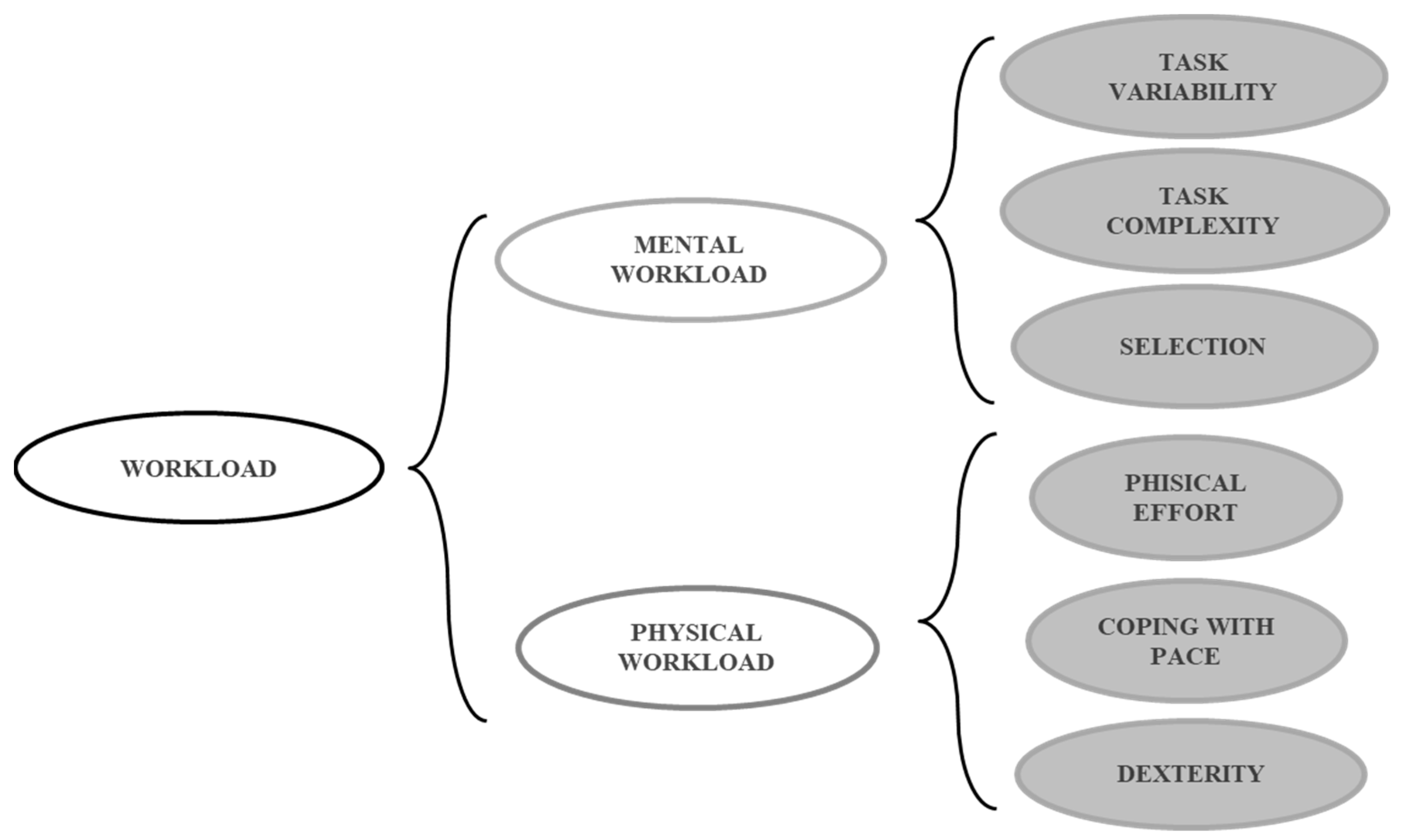
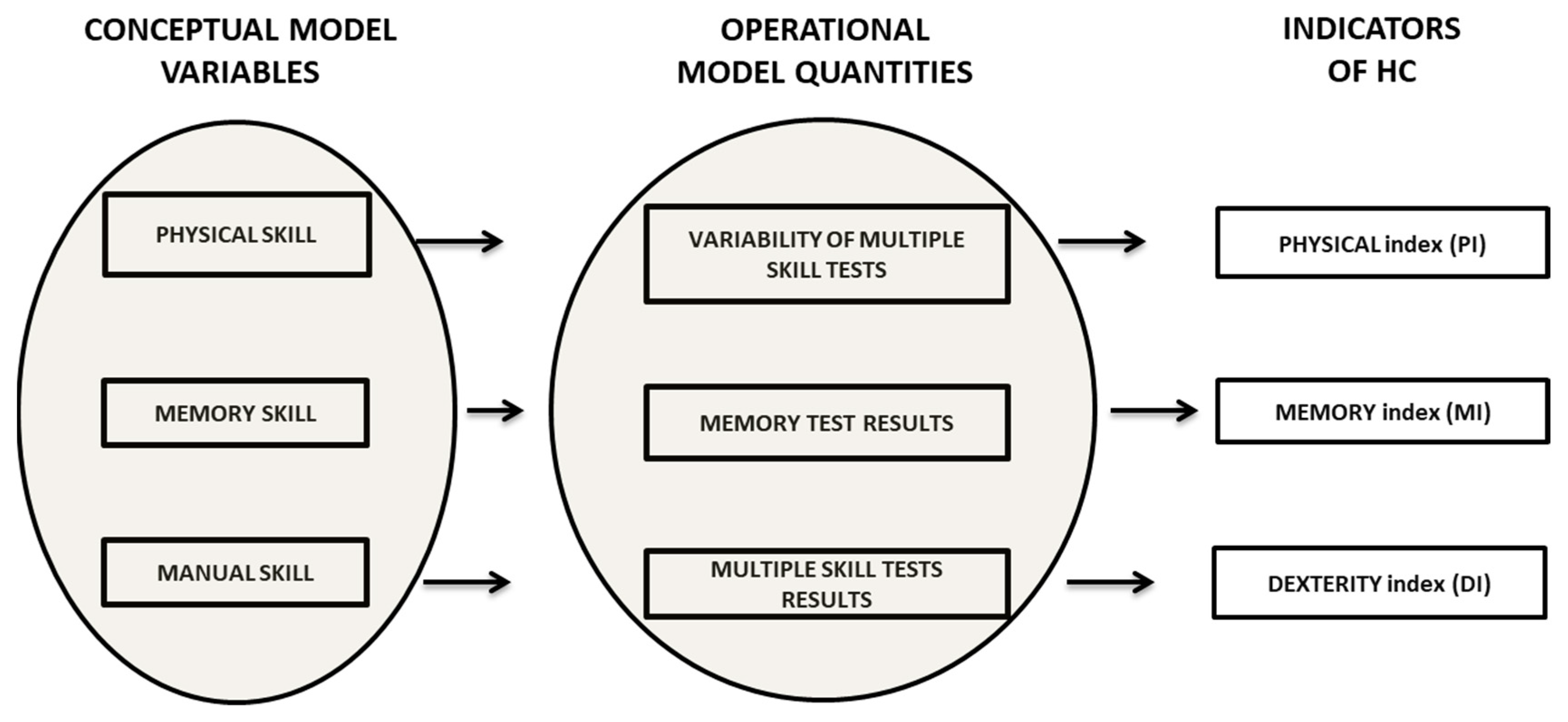

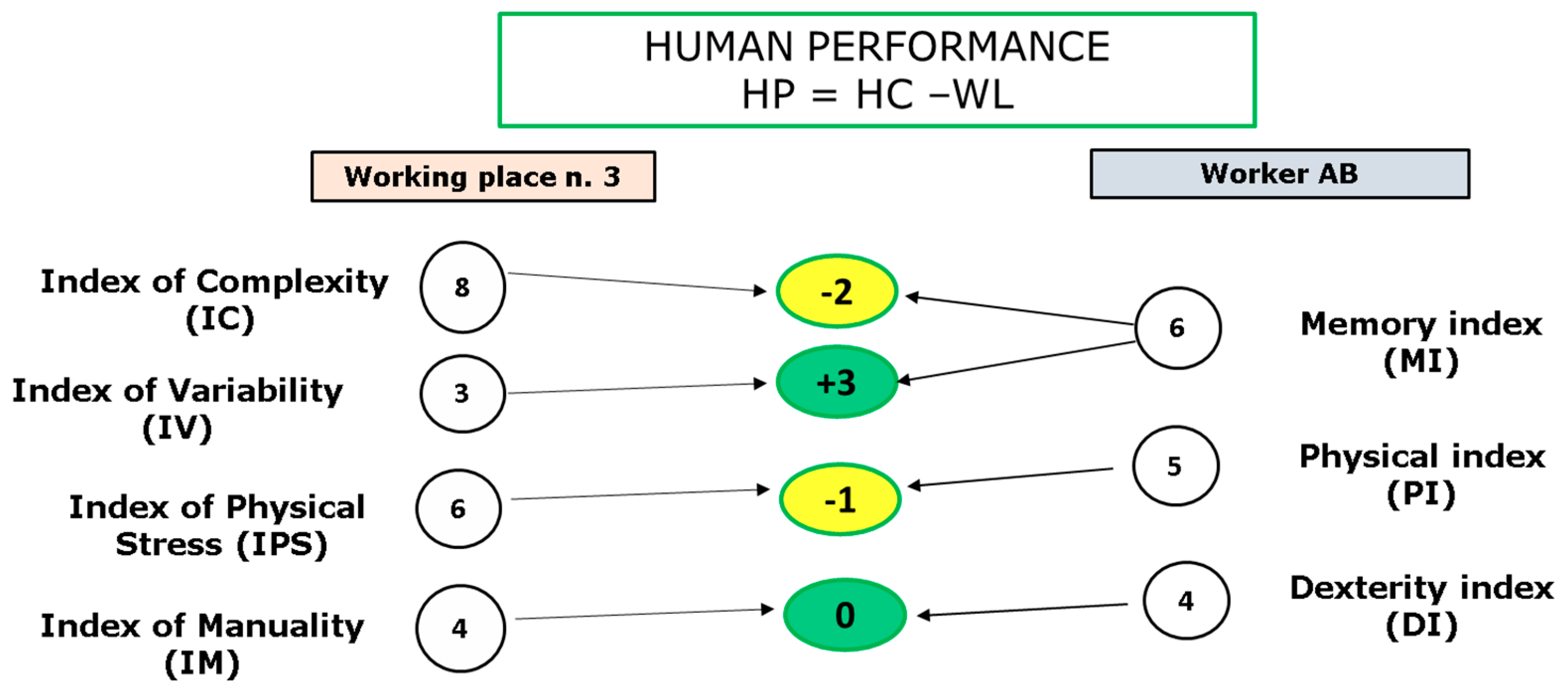

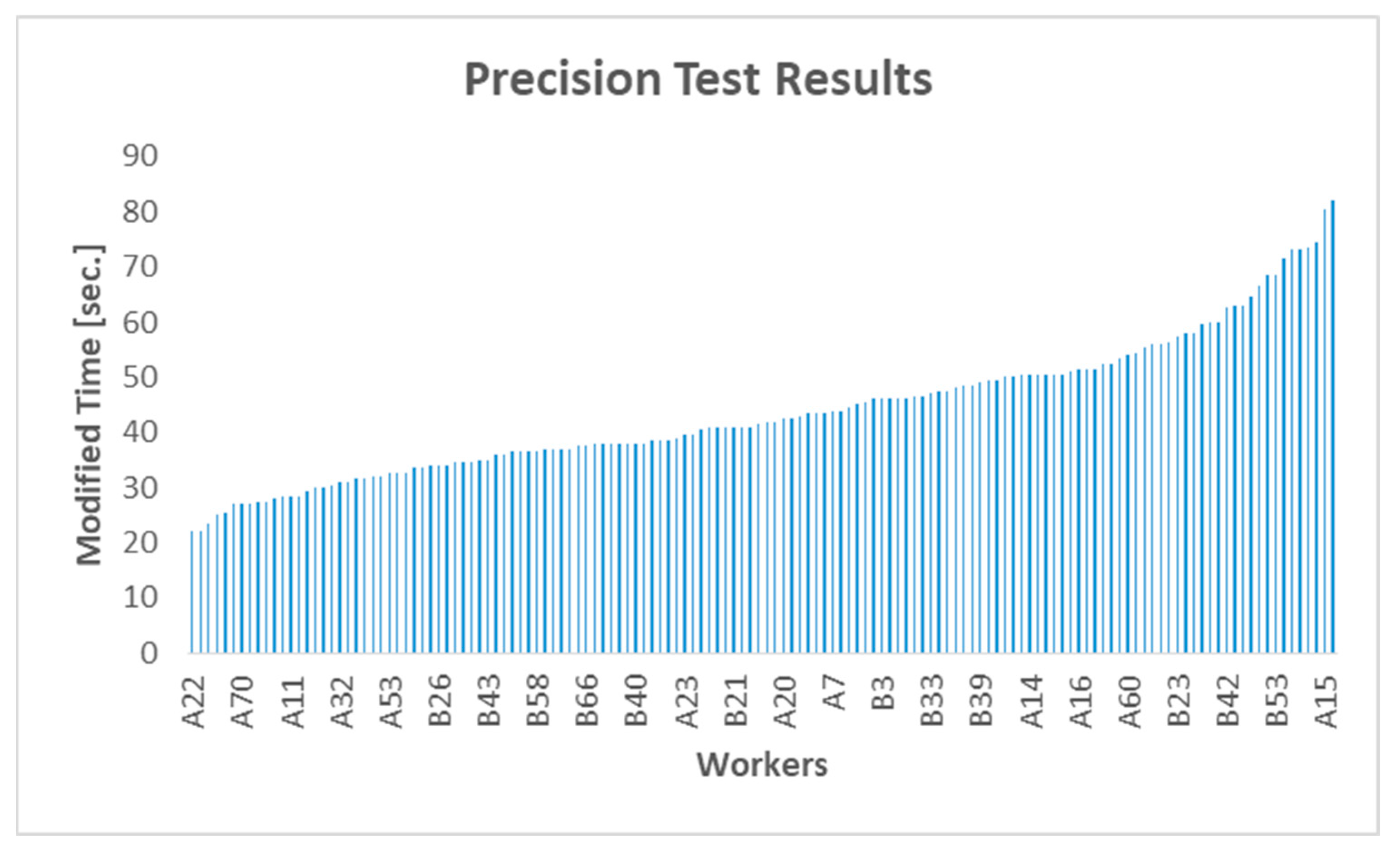
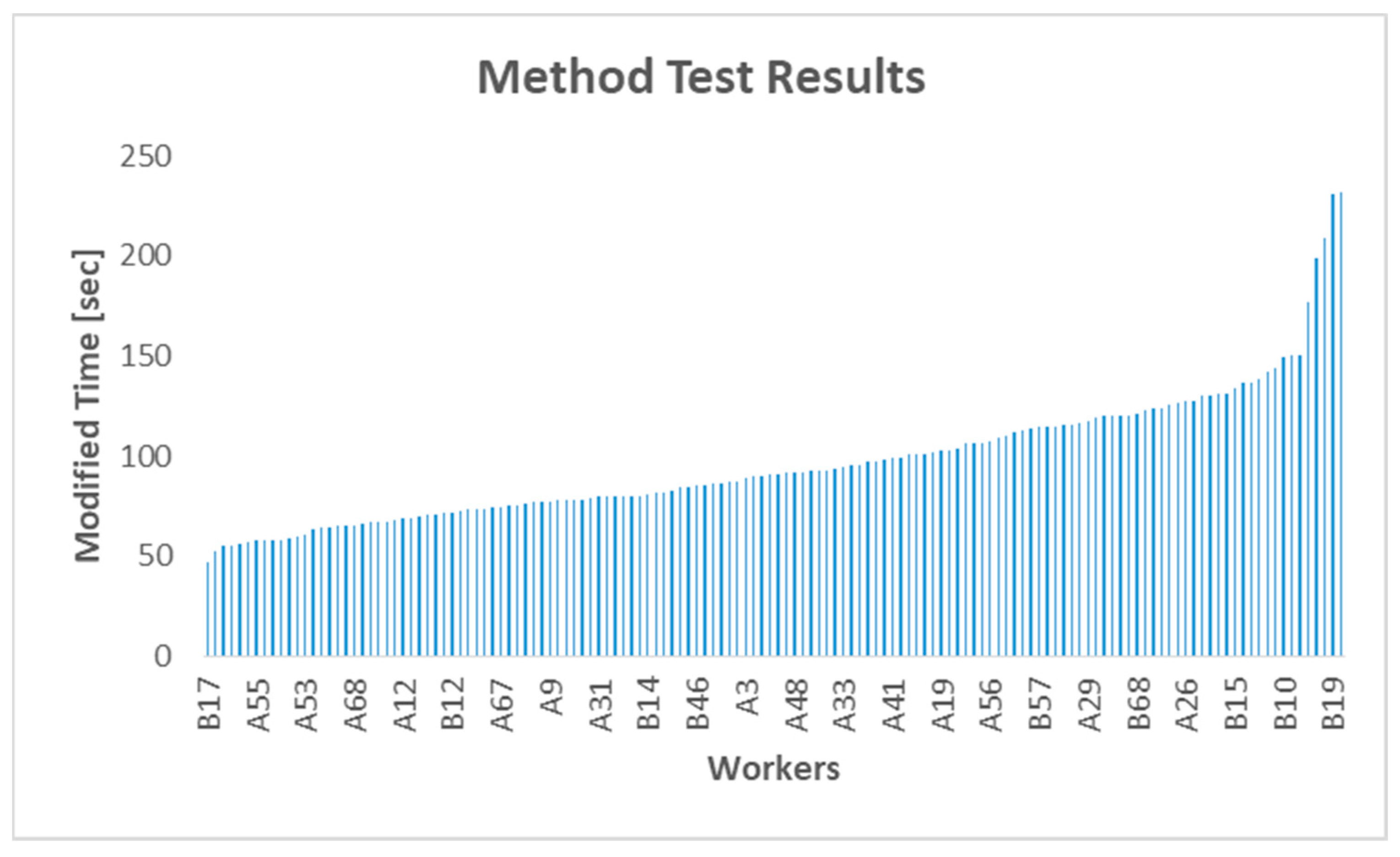



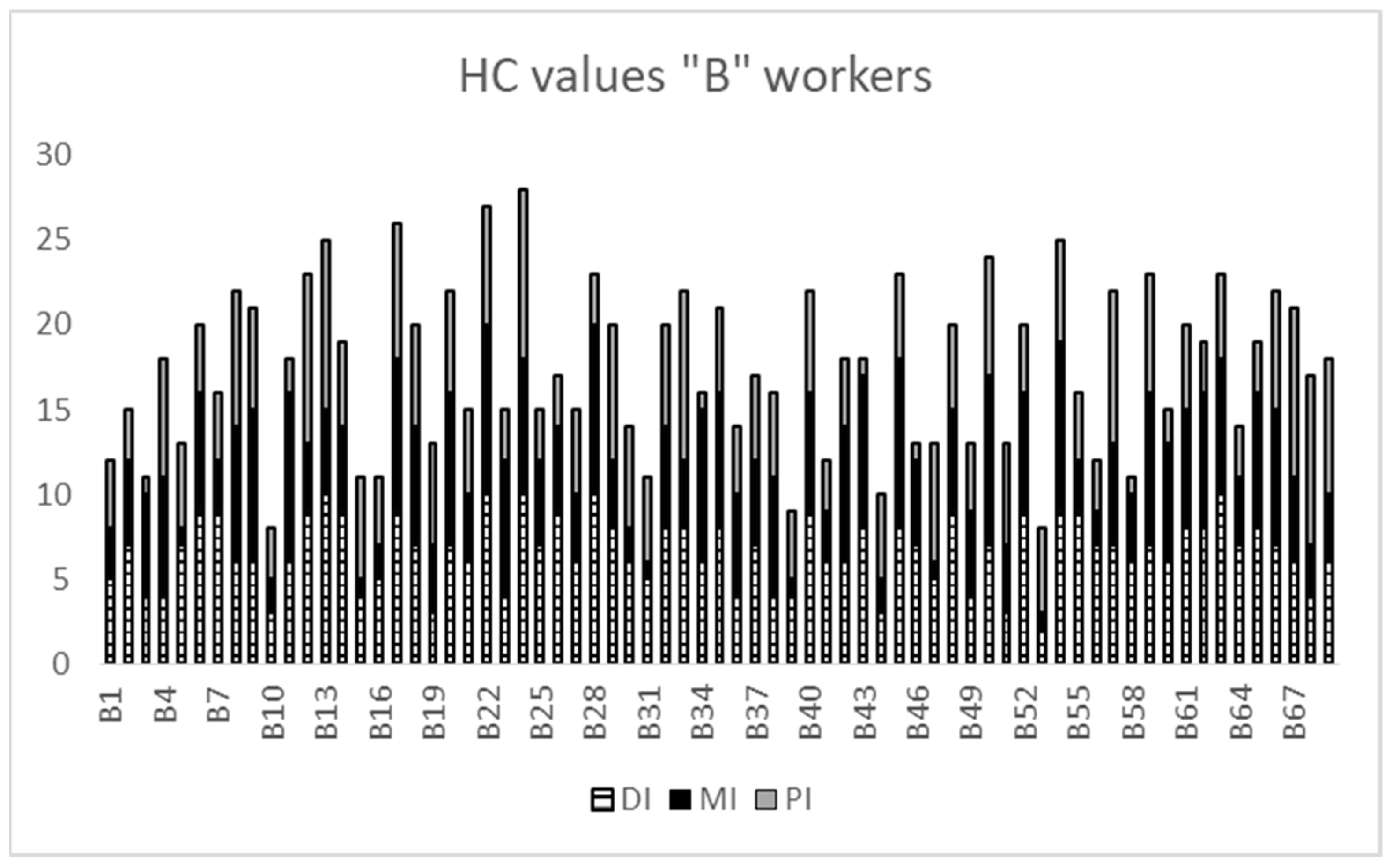
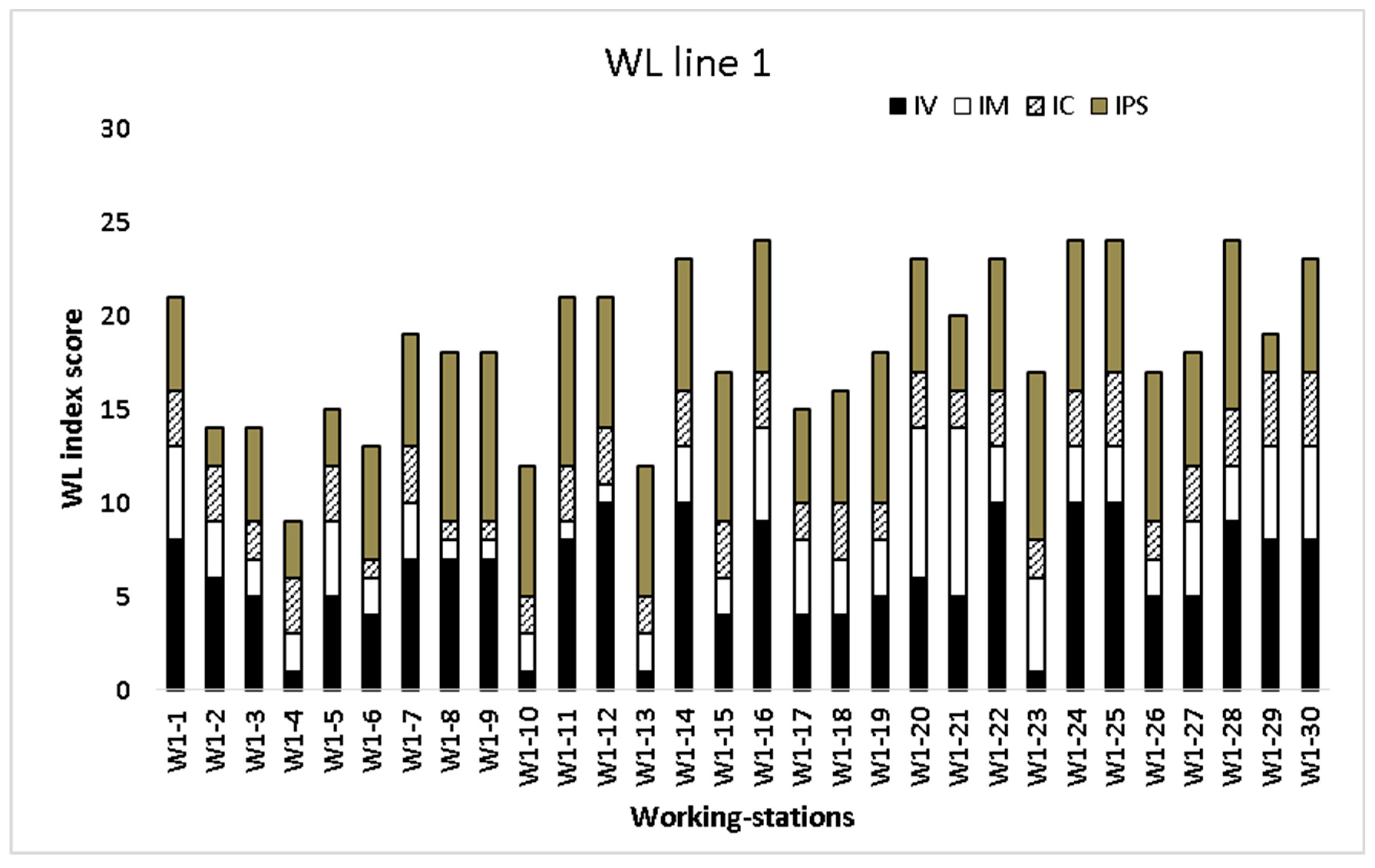
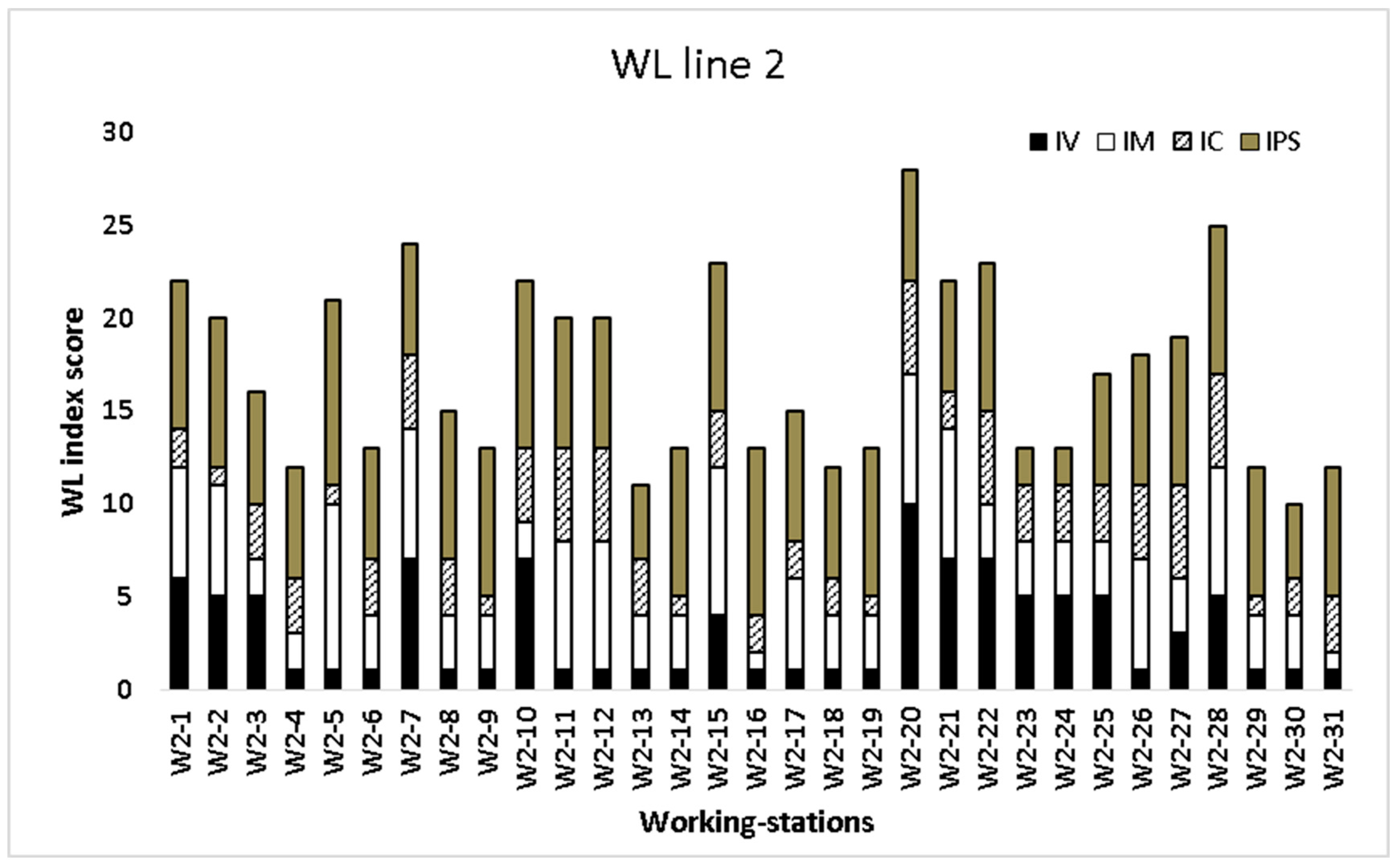
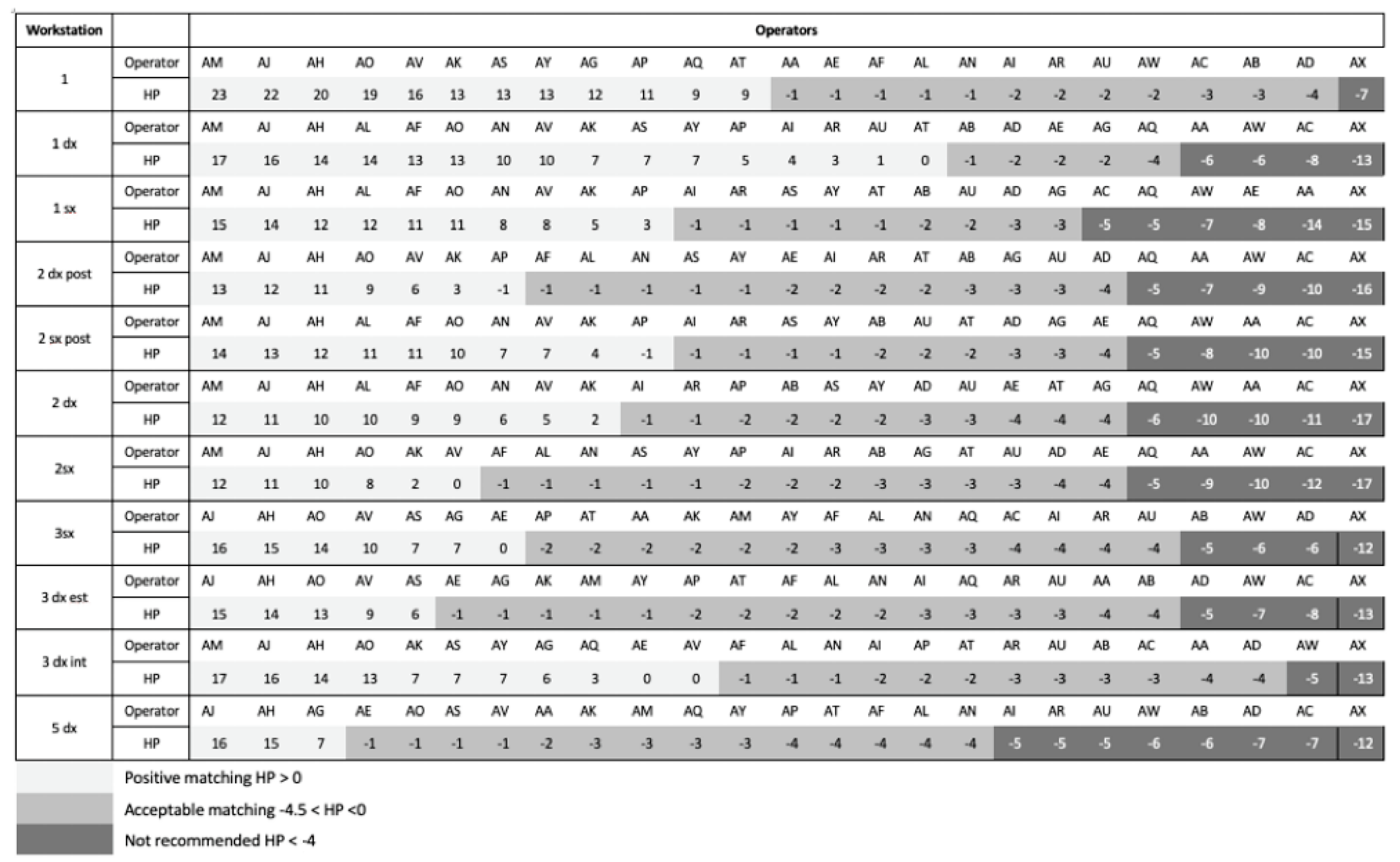
| Precision Test | Method Test | Both Hands Test | Memory Test | ||||
|---|---|---|---|---|---|---|---|
| Result | Likert Value | Result | Likert Value | Result | Likert Value | Result | Likert Value |
| <24 | 10 | <67 | 10 | <85 | 10 | <79 | 1 |
| 25–29 | 9 | 68–76 | 9 | 86–95 | 9 | 80–89 | 2 |
| 30–34 | 8 | 77–86 | 8 | 96–105 | 8 | 90–99 | 3 |
| 35–39 | 7 | 87–96 | 7 | 106–115 | 7 | 100–109 | 4 |
| 40–44 | 6 | 97–106 | 6 | 116–125 | 6 | 110–119 | 5 |
| 45–49 | 5 | 107–116 | 5 | 126–140 | 5 | 120–129 | 6 |
| 50–54 | 4 | 117–126 | 4 | 141–155 | 4 | 130–139 | 7 |
| 55–59 | 3 | 127–136 | 3 | 156–170 | 3 | 140–149 | 8 |
| 60–64 | 2 | 137–146 | 2 | 171–199 | 2 | 150–159 | 9 |
| >65 | 1 | >147 | 1 | >200 | 1 | >160 | 10 |
| Workstation | TC | HPm | Weighted HPm | |||
|---|---|---|---|---|---|---|
| 1 | 6 | 4 | 6 | 4 | 10 | |
| 2 | 8 | 8 | 2 | 2 | 10 | 16 |
| 3 | 3 | 1 | 7 | 9 | 10 | |
Disclaimer/Publisher’s Note: The statements, opinions and data contained in all publications are solely those of the individual author(s) and contributor(s) and not of MDPI and/or the editor(s). MDPI and/or the editor(s) disclaim responsibility for any injury to people or property resulting from any ideas, methods, instructions or products referred to in the content. |
© 2023 by the authors. Licensee MDPI, Basel, Switzerland. This article is an open access article distributed under the terms and conditions of the Creative Commons Attribution (CC BY) license (https://creativecommons.org/licenses/by/4.0/).
Share and Cite
Leva, M.C.; Demichela, M.; Albarrán Morillo, C.; Modaffari, F.; Comberti, L. Optimizing Human Performance to Enhance Safety: A Case Study in an Automotive Plant. Sustainability 2023, 15, 11097. https://doi.org/10.3390/su151411097
Leva MC, Demichela M, Albarrán Morillo C, Modaffari F, Comberti L. Optimizing Human Performance to Enhance Safety: A Case Study in an Automotive Plant. Sustainability. 2023; 15(14):11097. https://doi.org/10.3390/su151411097
Chicago/Turabian StyleLeva, Maria Chiara, Micaela Demichela, Carlos Albarrán Morillo, Franco Modaffari, and Lorenzo Comberti. 2023. "Optimizing Human Performance to Enhance Safety: A Case Study in an Automotive Plant" Sustainability 15, no. 14: 11097. https://doi.org/10.3390/su151411097
APA StyleLeva, M. C., Demichela, M., Albarrán Morillo, C., Modaffari, F., & Comberti, L. (2023). Optimizing Human Performance to Enhance Safety: A Case Study in an Automotive Plant. Sustainability, 15(14), 11097. https://doi.org/10.3390/su151411097






